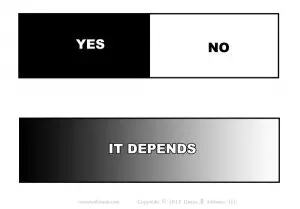Challenging Assumptions in Three Black and White Thinking Examples
The three black and white thinking examples below show just how easy problems arise when people aren’t challenging assumptions every day. This kind of thought drives people to see only one of two answers. Usually, it’s “yes” or “no.” Yes, it is. No, it isn’t.
Life though screws this up by with gray areas. For example, something could be done, but to what degree? What quality? Each makes his own assumptions in black and white thinking.

Black and white thinking usually occurs to avoid the gray complexities of unique facts and circumstances that change a good simple solution into a bad one.
Black and White Thinking Examples
Here are three black and white thinking examples. The first is an everyday
Example #1
Three of us threw a block party for our neighborhood. Two of us told the third to get some ice. When we saw him again, we asked, “Have you gone to get the ice yet?”
“Yes,” he replied. He bought one bag of ice. The problem was that we had six large coolers.
Example #2
A manager asked her customer service rep, “Did you solve the client’s problem?”
“Yes,” he replied. The next day the client called the manager to complain. The problem was that the customer service rep hadn’t solved it in the way the client liked very much.
Example #3
An owner asked his retail buyer, “Did you get that slow merchandise returned?”
“Yes,” she replied. A week later the owner got a huge bill for rushed delivery. He was upset. The problem was the buyer had to get the stuff back by a certain date.
Challenging the Anchors Black and White Thinking Drops
In each of these black and white thinking examples, they are closed questions. They make these examples easy to see. Yet, they don’t need to be questions:
- Tom, please get the ice for us.
- Howard, solve this customer problem for me.
- Louise, we need to get that slow merchandise returned now.
It’s harder to see black and white thinking in statements. In business, they often show up as assuming too much or giving poor instructions. “You never told me that,” is a common employee retort. The manager might counter with, “I should not have to micromanage you.”
These are closed statements because they anchor people’s thoughts in black and white terms:
- Get the ice or don’t get it.
- Solve the problem or don’t.
- Return the merchandise or don’t.
Nothing anchors their thoughts on “how.” How much ice? How do I solve (or return) this? Thus, when we challenge the assumptions in these black and white thinking examples, we pull up the anchors they drop in our minds.
Solutions Show Why Black and White Thinking Happens So Much
While a manager might not want to micromanage the employee, she can anchor “how” in his thoughts by saying,
- “Get enough ice for six coolers.”
- “Solve this to the customer’s satisfaction but within your cost allowance.”
- “Return the merchandise using our normal shipping rate guide.”
Of course, this adds time, thought and effort. Efficiency declines. Urgency might not allow it either. Black and white thinking is so much easier, quicker and more efficient. These are why we find it so much in business. These are also why so many problems arise with this black and white thinking too.
- How Challenging Assumptions Every Day Improves Problem Solving
- Challenging Assumptions Behind 1+1=2 As Case Study
- Challenging Assumptions Example
- Challenging Assumptions Exercises
- Solving Problems by Challenging All Things Equal Assumption
- 3 Common Examples of Challenging Assumptions at Work
- Challenging Assumptions in Three Black and White Thinking Examples
- Without Question Easiest Tip To Challenge Assumptions Like A Pro
- 6 Challenging Assumptions Exercises From Business


